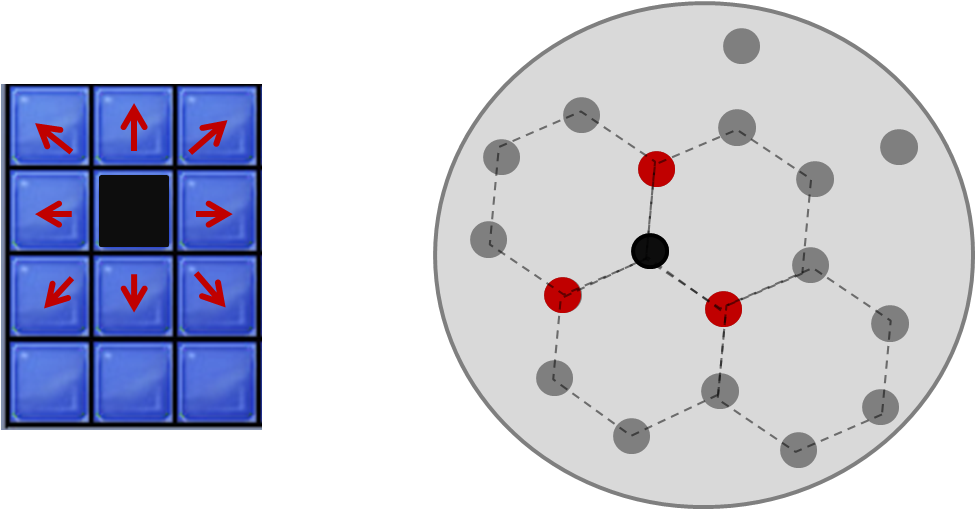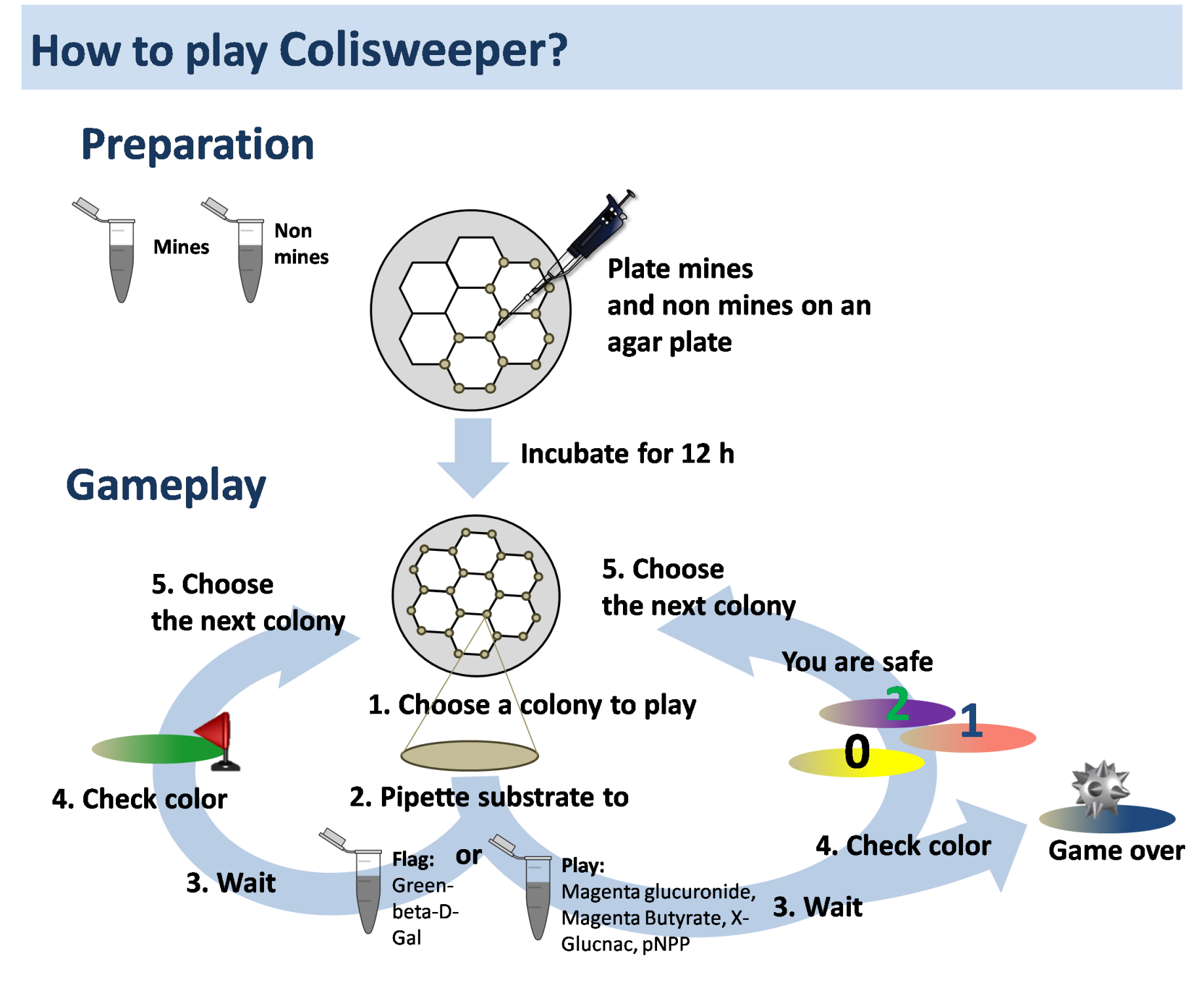Team:ETH Zurich/Play
From 2013.igem.org
| Line 3: | Line 3: | ||
<h1>Design of the mine grid for the bio-game</h1> | <h1>Design of the mine grid for the bio-game</h1> | ||
| - | [[File:Project description10.png|320px|left|thumb|<b>Figure 1: Project description</b> The different colors in the colonies represent each of the game states as in the computer game minesweeper. The numbers zero, one and two in the above picture represent the number of mines around the colony. The green colony corresponds to the flagging as in the computer game]] | + | [[File:Project description10.png|320px|left|thumb|<b>Figure 1.1: Project description</b> The different colors in the colonies represent each of the game states as in the computer game minesweeper. The numbers zero, one and two in the above picture represent the number of mines around the colony. The green colony corresponds to the flagging as in the computer game]] |
<p align="justify">Inspired by the computer game Minesweeper, we aspire to incorporate all the same features and rules in the biological version of the game. To replicate the "mouse click" in the computer game, the player adds a substrate to the colony of his or her choice which leads to a colorful [https://2013.igem.org/Team:ETH_Zurich/Experiments_3 enzyme-substrate] reaction. The agar mine field consists of colonies which can be one of the following: | <p align="justify">Inspired by the computer game Minesweeper, we aspire to incorporate all the same features and rules in the biological version of the game. To replicate the "mouse click" in the computer game, the player adds a substrate to the colony of his or her choice which leads to a colorful [https://2013.igem.org/Team:ETH_Zurich/Experiments_3 enzyme-substrate] reaction. The agar mine field consists of colonies which can be one of the following: | ||
<br><br><b>a non-mine colony</b>, which will display the "safe colour" when played | <br><br><b>a non-mine colony</b>, which will display the "safe colour" when played | ||
<br><b>a non-mine colony located close to one or two mines</b>, which on addition of a multi-substrate reveals the number of mines in the vicinity of this colony | <br><b>a non-mine colony located close to one or two mines</b>, which on addition of a multi-substrate reveals the number of mines in the vicinity of this colony | ||
<br><b>a mine colony</b>, which when played reveals the mine color and the game is over | <br><b>a mine colony</b>, which when played reveals the mine color and the game is over | ||
| - | <br>You also have the option to flag a mine - if you are certain that a colony is a mine, you can flag it using a second substrate.< | + | <br>You also have the option to flag a mine - if you are certain that a colony is a mine, you can flag it using a second substrate.</p><br clear="all"> |
| - | If we plate the bacterial colonies on an agar petridish similar to squares in the computer game, we would need a huge grid of bacterial colonies. In this case, each colony has a possibility to have eight mine colonies adjacent to it. To mimic the same pattern in a biological setting will be quite complicated. To have a simple grid structure, we decided on a grid with a hexagonal honeycomb-like pattern, where colonies are placed at all edges of the hexagon, except the center. In the hexagonal grid, the number of mine colonies around a chosen colony is restricted to only one, two or three. To plate the field, liquid cultures of mine and non-mine cells are grown to an OD<sub>600</sub> of 0.5, then, using a pipette, 1.5 μl of liquid culture are placed according to the grid.</p> | + | [[File:Colisweepergrid.png|500px|right|thumb|<b>Figure 1.2 Computer-game grid compared to the bio-game grid.</b> Red dots indicate adjacent receiver colonies, red arrows the adjacent squares in the computer-game. Teh black dot indicates the location of the mine.]] |
| + | <p>If we plate the bacterial colonies on an agar petridish similar to squares in the computer game, we would need a huge grid of bacterial colonies. In this case, each colony has a possibility to have eight mine colonies adjacent to it. To mimic the same pattern in a biological setting will be quite complicated. To have a simple grid structure, we decided on a grid with a hexagonal honeycomb-like pattern, where colonies are placed at all edges of the hexagon, except the center. In the hexagonal grid, the number of mine colonies around a chosen colony is restricted to only one, two or three. To plate the field, liquid cultures of mine and non-mine cells are grown to an OD<sub>600</sub> of 0.5, then, using a pipette, 1.5 μl of liquid culture are placed according to the grid.</p> | ||
<br clear="all"/> | <br clear="all"/> | ||
Revision as of 11:30, 25 October 2013
Design of the mine grid for the bio-game

Inspired by the computer game Minesweeper, we aspire to incorporate all the same features and rules in the biological version of the game. To replicate the "mouse click" in the computer game, the player adds a substrate to the colony of his or her choice which leads to a colorful enzyme-substrate reaction. The agar mine field consists of colonies which can be one of the following:
a non-mine colony, which will display the "safe colour" when played
a non-mine colony located close to one or two mines, which on addition of a multi-substrate reveals the number of mines in the vicinity of this colony
a mine colony, which when played reveals the mine color and the game is over
You also have the option to flag a mine - if you are certain that a colony is a mine, you can flag it using a second substrate.
If we plate the bacterial colonies on an agar petridish similar to squares in the computer game, we would need a huge grid of bacterial colonies. In this case, each colony has a possibility to have eight mine colonies adjacent to it. To mimic the same pattern in a biological setting will be quite complicated. To have a simple grid structure, we decided on a grid with a hexagonal honeycomb-like pattern, where colonies are placed at all edges of the hexagon, except the center. In the hexagonal grid, the number of mine colonies around a chosen colony is restricted to only one, two or three. To plate the field, liquid cultures of mine and non-mine cells are grown to an OD600 of 0.5, then, using a pipette, 1.5 μl of liquid culture are placed according to the grid.
Colisweeper gameplay
To play Colisweeper, the gamer has to plate mines and non mines on an agar plate 12 h previous to the actual game. After 12 h of incubation the game is ready to be played. The player has to pipette colorless substrates on a colony on the agar minefield. A single move of pipetting would require the player to choose between two substrates. To "play" a colony, the player pipettes a multi-susbtrate mix, which reveals the identity of the colony- as in the number of mines surrounding a non-mine. If the colony turns yellow, red or violet, this means that zero, one or two mines are adjacent to the "played" colony, respectively. This means you are safe and can perform your next move. However if the colony turns blue, you hit a mine and the game is over. If you want to flag a colony, the single substrate is pipetted onto a colony if the player is certain it is a mine. Upon this the colony turns green. Addition of either substrate produces a defined colored product within minutes, allowing identification of the played colony and the number of mines surrounding it.
 "
"







